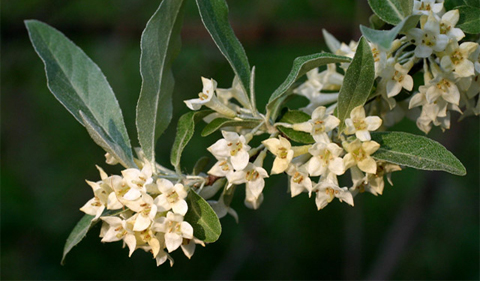By Kevin Knavish
Environmental and Plant Biology Student interning at the Wayne National Forest
On the Wayne, as well as many other Eastern-American forests, the invasive bush Autumn Olive, Elaeagnus umbellata of the Elaeagnaceae family, has infested and dominated large areas by outcompeting native species.
The Autumn Olive can grow up to 20 feet tall be easily identified by the silvery underside of its leaves and cream to yellow flowers. The bush was introduced to the United States from China, Korea, and Japan, and in the 1950s it was planted in disturbed environments to create animal habitat and to minimize erosion damage.
The roots of Elaeagnus umbellata can fix nitrogen and survive in a variety of different soil types. Autumn Olive’s ability to grow and reproduce quickly is enhanced by its ability to produce up to 200,000 seeds per year, and the consumption and dispersion of their seeds by birds.
The presence of Autumn Olive can displace native species by growing to large sizes and dominating light availability.
Works Cited
“Journey with Nature: Autumn Olive.” Red Foxes in Indiana | The Nature Conservancy, 2018, www.nature.org/ourinitiatives/regions/northamerica/unitedstates/indiana/journeywithnature/autumn-olive.xml.
National Invasive Species Information Center. “Autumn Olive (Elaeagnus Umbellata).” National Invasive Species Information Center, 12 May 2018, www.invasivespeciesinfo.gov/plants/autmnolive.shtml.
“Plants Profile for Elaeagnus Umbellata (Autumn Olive).” Plants Profile for Taxodium Ascendens (Pond Cypress), plants.usda.gov/core/profile?symbol=elum.
Nancy Loewenstein. “Autumn Olive.” Michigan Invasive Species, Auburn University, https://www.michigan.gov/invasives/0,5664,7-324-68002_71240_73850-368763–,00.html’
Evans, Chris. “Autumn Olive.” Michigan Invasive Species, Wildlife Action Plan, www.michigan.gov/invasives/0,5664,7-324-68002_71240_73850-368763–,00.html.




















Comments